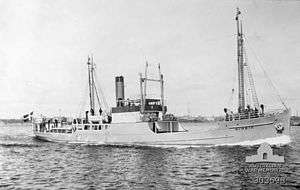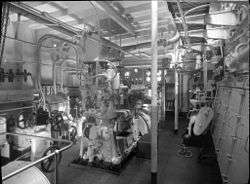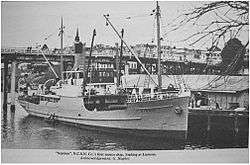MV Nimbin
 | |
| History | |
|---|---|
| Name: | Nimbin |
| Owner: | North Coast Steam Navigation Company |
| Port of registry: | Sydney, Australia |
| Route: | North Coast Butter Run |
| Builder: | Burmeister & Wain, Copenhagen, Denmark |
| Maiden voyage: | 21 June 1927, from Copenhagen to Sydney in 65 days |
| In service: | 14 September 1927 |
| Out of service: | 5 December 1940 |
| Identification: | Official Number: 155313 |
| Fate: | Sunk by German naval mine |
| General characteristics | |
| Type: | Steel Motor Vessel |
| Tonnage: |
1,052 GRT 516 NRT |
| Length: | 65.53 m (215 ft 0 in) |
| Beam: | 10.66 m (35 ft 0 in) |
| Draught: | 3.352 m (11 ft 0 in) |
| Installed power: | Burmeister & Wain diesel engine 1,000 horsepower (750 kW) |
| Propulsion: | Single Screw |
| Speed: | 12.1 knots (22.4 km/h; 13.9 mph) |
| Capacity: | 60,900 cubic feet, and fitted for refrigerated cargo |
| Crew: | 20 |
The Nimbin was a steel screw steamer built in 1927 at Copenhagen, that was the first motor vessel placed into the New South Wales coastal trade it was owned and operated by the North Coast Steam Navigation Company and was the first Australian registered merchant ship to be lost during World War II when it struck a mine laid by the German auxiliary cruiser Pinguin. The Nimbin was on its way from Coffs Harbour to its home port, Sydney, with a cargo of bundled three-ply timber and a large number of pigs. One third of the ship was blown away and it sank in three minutes. Seven men were killed. The remaining thirteen clung to bundles of plywood. Some hours later an air force plane from RAAF Base Rathmines saw the survivors and directed the coastal ship SS Bonalbo to the scene to pick up the survivors.
Ship Description & Construction
The Nimbin was the first motor ship to be employed on the New South Wales coast, and run between Sydney and the northern rivers.[1] The vessel was built on the slips at the yards of the builders, Burmeister and Wain in Copenhagen and completed in late June 1927 Upon arrival in Sydney the vessel was described as
The Nimbin is a vessel of 1,052 GRT with a length of 215 ft 0 in (65.53 m), a width of 35 ft 0 in (10.67 m), and a depth of 13 ft 0 in (3.96 m). She has a total cargo space of 60,900 cubic feet, and is fitted for the carrying of refrigerated cargo. She ¡s a single-screw vessel, propelled by a Burmeister and Wain 6-cylinder 4-cycle Diesel marine engine, with two auxiliary engines for maintaining the electric light and refrigerating services, and for working the winches and other gear. At her speed trials she developed 12.1 knots. A feature of the vessel is the accommodation for the crew, who have, for Instance, a bathroom fitted with hot and cold showers, in fresh and salt water. The three lifeboats are fitted with patent disengaging gear, which it is claimed, can be set afloat by unskilled hands in the space of half a minute.[2]
Ship service history
Delivery and Maiden Voyage


The Nimbin left Copenhagen, her launching port under the command of Captain R.M. Beedie on June 21 with a cargo of 305,000 superficial feet of Baltic pine from Hargshamn, Sweden and completed the journey to Sydney on the 27 of August in 65 days. During the delivery voyage the vessel ran into a gale in the Red Sea (the so-called “calm belt”) which continued unabated for four days.[2] Upon passing out of the Red Sea, the vessel then encountered the full force of the monsoonal winds, which persisted until it reached Colombo. Then from Colombo to Cape Leeuwin the ship was, in the words of her officers, "under water the whole way," and lost a quantity of her deck cargo of timber. Through it all the Nimbin did not once develop engine-trouble.[2]
After arrival, the vessel was taken to Mort's Dock for inspection and was docked for overhaul before being placed in commission and into the so-called North Coast Butter Run to the Clarence and Richmond River[2] a similar but of lighter draught vessel was then ordered for use in the Macleay River trade.
The North Coast Steam Navigation Company's then new motor ship left Sydney on the afternoon of Tuesday 13 September 1927 on her maiden voyage in the coastal trade. She is the first motor ship to be employed on the New South Wales coast, and ran between Sydney and the Clarence River.[3]
Early Incidents



7 Weeks after going into service Frederick Hoskins the second officer on the ship, was fatally injured on 2 November when he fell down the hold of the vessel while the ship was between Lismore and Ballina. At the time the crew, under the direction of Hoskins, were erecting a chute for the loading of sugar when, by some unknown means, Hoskins fell the 15 feet into the hold. He was put ashore and taken find to Coraki Hospital, where he died the following morning.[4]
Nearly a year later in mid October 1928 while coming in across the Richmond bar the Nimbin touched the northern wall lightly causing the steering gear carried away and some slight damage was done to one of the plate at the water line. Temporary repairs were affected at Ballina. The steamer proceeded up the river, no tug was available to help the disabled vessel and had the accident happened further out the steamer may have become a wreck.[5]
Ballina Grounding

At 6am on Monday the 22 February 1932 in a heavy fog the Nimbin went ashore about three miles south of Ballina Heads. The sea was calm at the time, with the fog driving from the north. The ports pilot at Ballina, Captain Lyttle, on learning of the plight of the Nimbin, immediately left port in a motor launch and called upon the dredge Tethys commanded by Captain Munro, was ordered t o he scene at about 7:30 am, and stood by the stranded vessel. A heavy cable was passed on board and an attempt was made to tow her off, but a fall in the tide had left the Nimbin more firmly wedged on the sand The attempt was abandoned for the time, and it was decided to await the high tide and the arrival of stronger salvage gear. So the dredge returned to port to take on more coal and to take out the cables and anchors which are available at Ballina for salvage purposes she and returned to the Nimbin in the afternoon, but her efforts met with no success.[6]
The North Coast S.N. Company ordered their steamer Ulmarra, which was close by, to proceed to the Nimbin, and it is hoped that she will be able to effect a salvage on the following mornings flood tide as it was thought that it should be powerful enough to tow the Nimbin off the sand if the Nimbin’s position did not become worse during the night. Additionally the company ordered its steamer Arakoon to leave Sydney with Captain D W Gibson, of the Sydney Marine Underwriters' and Salvage Association on board the latest salvage gears being taken to Ballina by Captain Gibson on the Arakoon.[6]
After being aground on the beach for 24 hours the Nimbin was success-fully refloated under her own power about 9:15am Tuesday 23 February. The cargo was intact but a quantity of oil was pumped from the tanks The company's vessel Ulmarra, which had been ordered to the scene, was standing by, and had a tow line aboard, but her assistance was not required The dredge Tethys from Ballina also stood by. Sea anchors had been placed some distance to seaward, and were secured with lines to the Nimbin When the tide was at flood, the Nimbin’s motors were started, and she hauled on the anchors, and soon slid off the sand The salvage gear had been taken to the Nimbin on Monday night After picking up the gear the Nimbin proceeded inside the Richmond River, safely negotiating the bar She then commenced to discharge her Sydney cargo The Ulmarra proceeded to the Clarence River. Captain Raymer, of the Nimbin, stated that the vessel was travelling at half speed in a heavy haze, which was hanging low over the sea, when the stranding occurred He said that no damage had been done to the vessel.[7]
The steamer Arakoon which had been loaded a quantity of salvage gear and had dispatched from Sydney late on the Monday night to assist the Nimbin was advised the same morning that the Nimbin was refloated by a message sent from the lighthouse-keeper at Seal Rocks.[7]
Later Incidents

In late December 1934 the Ulmarra was partly disabled, by the loss of a propeller blade when the blade was snapped off when it came into contact with a submerged object in the Clarence River the Nimbin came to assistance and towed the Ulmarra the voyage of nearly 300 miles. The master of the Ulmarra (Captain Bysanton) said that the Ulmarra was not rendered helpless by the accident, and she could, if necessary, have steamed unaided, but as the motor ship Nimbin, was coming down to Sydney from Richmond River it was considered advisable for her to assist. During the long tow the Ulmarra was able to run her engines, and at times a speed of well lover 11 knots was attained.[8]
On Thursday the 9 September 1937 the Nimbin and the small tug Teven collided on the Richmond river near Coraki and Joseph Smith, 72, the engine driver of the tug Teven was killed, and Charles Young, a seaman on the Teven, was seriously injured. The Teven was towing a timber barge when the collision occurred, Young, who was steering, was hurled on to the barge, suffering severe Injuries to the back. Smith, who was in charge of the engine, was crushed and flung into the water. His leg was smashed practically to pulp, and he was dead when picked up.[9]
While coming down the coast in July 1938 the Nimbin came across the coastal motor vessel Comara that had a mechanical breakdown where a bolt had broken and some cogs were partially stripped in their engine room while the vessel had been just north of Seal Rocks and fortunate to escape to get into Seal Rocks Bay for shelter. Had the Comara been farther on shelter would not have been available, and, as the wind was high at the time. The Nimbin took the Comara in tow at Seal Rocks and brought the vessel into Newcastle during the night[10]
Shipwreck event

Early in the World War II, the German auxiliary cruiser Pinguin had laid a number of mine fields between Newcastle and Sydney as well as off the eastern and southern coasts of Australia. Their first victims were the British cargo ship Cambridge off Wilsons Promontory, on 7 November 1940, and the day after, the American merchant ship City of Rayville which sank off Cape Otway. This was in fact the first American casualty of the war, in which the USA was not yet involved.[11]
Then a month later, on 5 December 1940, The Nimbin was the first Australian registered merchant ship to be lost when it ran into a mine off Norah Head on the Central Coast. It was on its way from Coffs Harbour back to Sydney, with a cargo of three-ply timber packed in bundles and a large number of pigs.[11]
Without warning, there was a large deafening explosion at 3.25 p.m. just aft of the engine room where the whole after section or about a third of the vessel had disappeared and the vessel settling by the stern. The explosion resulted in timber and debris being shot into the air as well as oil from the fuel tanks spurted up like a geyser. Luckily the oil didn't catch fire. And seconds later the survivors found themselves in the calm sea struggling around grasping bundles of plywood six feet long and three feet wide which were scattered over a fairly wide expanse of sea. The bundles of plywood acted as life rafts as there had been no chance of even getting near the life-boats, let alone launching any of them. There had been no chance of sending out a wireless distress call.[12]
At 3.15 p.m. an amphibian aircraft, piloted by a senior officer of the RAAF based on the Rathmines, took off on a reconnaissance flight to seaward. Soon after taking off the pilot saw smoke several miles out to sea he altered course and made for the spot immediately. He found a great deal of wreckage was floating on the surface with the amphibian sighting the wreck site within ten minutes of the explosion an. The pilot landed the plane but found the water much rougher than he had expected. Because of the seas and the extent of the wreckage, he was unable to taxi close to one large piece of the flotsam, to which he could see a group of men clinging desperately. He taxied the machine some distance to the lea of a small island, where sheltered water enabled him to take off.[13]
The pilot intended to return directly o his base to obtain help. Soon afterwards, however, he sighted another ship in the vicinity. Flying low, he signalled to it with an Aldous lamp, informing it of the position of the wreckage and directing it to steam immediately to the scene.[13]
The SS Bonalbo arrived about two and a half hours after the explosion to pick them up at approximately 6 pm. An ambulance met them and rushed the injured to hospital. The rest, in clothes borrowed from their rescuers on the Bonalbo, were sent home by car. At the time most of the Nimbin’s crew were old employees of the North Coast Steam Navigation Company. Captain Bryanston and the Chief Officer Charles Chapman, who both died, had been with the company for 20 years and 26 years respectively.[11]
Crew at the time of sinking

Captain William James Bysantson, Chief Officer Charles George Chapman
Able Seaman William Gorry, Donkeyman Ernest Wilfred Carlson
| Name | Position | Age | Status |
|---|---|---|---|
| William James Bysantson | Master | 57 | Killed |
| Ernest Walter Hallett | Wiper | 60 | Killed |
| Ernest Wilfred Carlson | Donkeyman | 56 | Killed |
| Nils Hulton | Greaser | 60 | Killed |
| Charles George Chapman | Chief Officer | 56 | Killed |
| Archibald McAllister | 3rd Engineer Officer | 47 | Killed |
| William Gorry | Able Seaman | Killed | |
| Arthur Nicklen | Able Seaman | Injured - fractured right arm | |
| Emil Andersen | Able Seaman | Injured - injuries to back and head | |
| Charles Cartwright | Able Seaman | Injured - spinal injuries | |
| John Reynolds | Boatswain | Injured - fractured kneecap | |
| Stuart Kennedy | First Engineer | Uninjured | |
| Thomas Humphrey | Second Mate | Uninjured | |
| Frederick Whelan | Second Engineer | Uninjured | |
| Edward Green | Forth Engineer | Uninjured | |
| William Pry? | Able Seaman | Uninjured | |
| Walter Nicholson | Able Seaman | Uninjured | |
| Christopher Banks | Able Seaman | Uninjured | |
| David Powell | Cook | Uninjured | |
| Frederick Gough | Steward | Uninjured |
References
- ↑ The Sydney Morning Herald. 6 July 1927. p. 16 http://nla.gov.au/nla.news-article16380854. Retrieved 21 August 2012. Missing or empty
|title=(help) - 1 2 3 4 The Sydney Morning Herald. 29 August 1927. p. 12 http://nla.gov.au/nla.news-article16400143. Retrieved 21 August 2012. Missing or empty
|title=(help) - ↑ The Sydney Morning Herald. 14 September 1927. p. 19 http://nla.gov.au/nla.news-article28054308. Retrieved 21 August 2012. Missing or empty
|title=(help) - ↑ The Sydney Morning Herald. 3 November 1927. p. 16 http://nla.gov.au/nla.news-article16416042. Retrieved 21 August 2012. Missing or empty
|title=(help) - ↑ The Sydney Morning Herald. 16 October 1928. p. 15 http://nla.gov.au/nla.news-article16501966. Retrieved 21 August 2012. Missing or empty
|title=(help) - 1 2 The Sydney Morning Herald. 23 February 1932. p. 9 http://nla.gov.au/nla.news-article16842558. Retrieved 21 August 2012. Missing or empty
|title=(help) - 1 2 The Sydney Morning Herald. 24 February 1932. p. 11 http://nla.gov.au/nla.news-article16843081. Retrieved 21 August 2012. Missing or empty
|title=(help) - ↑ Sydney Morning Herald. 21 December 1934. p. 12 http://nla.gov.au/nla.news-article17138049. Retrieved 21 August 2012. Missing or empty
|title=(help) - ↑ The Sydney Morning Herald. 10 September 1937. p. 12 http://nla.gov.au/nla.news-article17418393. Retrieved 21 August 2012. Missing or empty
|title=(help) - ↑ The Sydney Morning Herald. 12 July 1938. p. 12 http://nla.gov.au/nla.news-article17481386. Retrieved 21 August 2012. Missing or empty
|title=(help) - 1 2 3 Journal of the Australian Maritime Officers Union (PDF). 15 (1). October 2006 http://www.amou.com.au/media/2560/august%2006.pdf. Retrieved 21 August 2012. Missing or empty
|title=(help) - ↑ The Daily News. 6 December 1940. p. 1 http://nla.gov.au/nla.news-article78537940. Retrieved 27 August 2012. Missing or empty
|title=(help) - 1 2 Examiner. 6 December 1940. p. 1 [1 http://nla.gov.au/nla.news-article52392148 1 http://nla.gov.au/nla.news-article52392148] Check
|url=value (help). Retrieved 27 August 2012. Missing or empty|title=(help) - ↑ "Australia @ War". Retrieved 21 August 2012.
- ↑ The Sydney Morning Herald. 6 December 1940. p. 9 http://nla.gov.au/nla.news-article17699898. Retrieved 26 August 2012. Missing or empty
|title=(help)
Coordinates: 33°15.392′S 151°46.976′E / 33.256533°S 151.782933°E